We Tested Traeger Grills to Find the Best for Grilling, Smoking, and Baking
Dotdash Meredith and Yahoo Inc. may earn commission or revenue on some items through the links below.
These top performers have features for every griller, from portability to Wi-Fi connectivity.
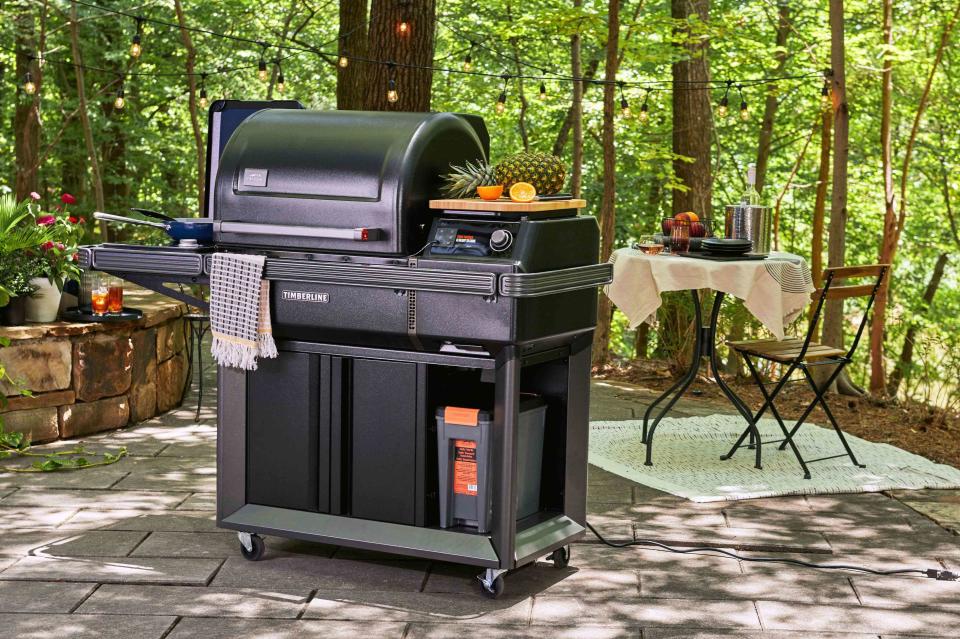
Food & Wine / Will Dickey
Traeger sold its first grill in 1988, incorporating wood pellets as fuel for a more reliable heat than gas or charcoal. With the ability to regulate the temperature via the volume of pellets fed into the ignitor, the Traeger design could be a hot-cooking grill or a slow-cooking smoker, equally suitable for meats or vegetables, with the press of a few buttons.
As the inventor of the pellet grill, the company has grown through multiple iterations, maintaining its position as one of the best-selling pellet grill manufacturers for decades. From its humble beginnings in Oregon, Traeger now offers multiple lines of grills. Yet, the many options can be confusing for a consumer to navigate. From the most basic, bare-bones models to the highest end, these are the product lines in a nutshell.
The Portables are what they sound like, with limited features.
The Pro series is a mid-range option, larger than the Portables, now offering Wi-Fi connectivity.
The Ironwood series steps up from the Pros and offers larger sizes, Wi-Fi connectivity, and a few new features, like DownDraft Exhaust, Super Smoke, and TRU Convection that speed and enhance cooking.
The luxury Timberline series offers even larger sizes, the aforementioned tech, new cart designs, and induction cooktop side burners.
We put six models through rigorous testing, considering factors like assembly, heat control, capacity, features, and overall performance. Read on to learn about how to select the best Traeger grill for your backyard.
Best Overall: Traeger Pro 780

Pros: This grill has a large capacity and is excellent for searing and short smoking projects.
Cons: It’s subject to significant temperature dips when opening and doesn’t deliver a lot of smoke flavor during long smoking tests.
We selected the 780 as best in class, not because it achieved the highest marks but because it achieved the highest marks for a grill at its attainable price point. It has a high capacity compared to other models and performed admirably in searing and short-smoking tests, providing a balanced, smoky flavor to chicken wings.
The 780 has all of the features a griller might look for and then some. “What really stands out are the additional features like WiFIRE capability, the digital control panel and menu, and cooking consistency,” says one tester. Setup is easy and intuitive, and the components are easily broken down for cleaning, though the heat shield can be stubborn. All in all, the grill heats quickly with no hot spots, despite a notable temperature dip after opening the grill. But the recovery time is markedly short unless you’re working at the highest temperatures.
Price at time of publish: $1,000
Dimensions: 27 x 49 x 55 inches
Cooking Area: 780 square inches
Weight: 150 pounds
Max Temperature: 500 degrees Fahrenheit
Hopper Capacity: 18 Pounds

Food & Wine / Russell Kilgore
Best Splurge: Traeger TBB86RLG Timberline Pellet Grill

Pros: Even heating, quick recovery, and almost an excess of features make this grill worth the price.
Cons: It’s expensive, and the hopper lid gets very hot during cooking, making refilling it a chore.
To call the Timberline “feature-rich” would be a disservice. This grill gives you ridiculously easy control, thanks to an included induction side burner, Wi-Fi and Bluetooth capabilities, and a digital control panel, which, as one tester describes it, “seems like it belongs on a spaceship that's on its way to explore distant and smoky new worlds.”
The Timberline scored 5/5 in every category tested: excellent heat control, smoky flavor, and searing, along with easy setup and cleanup. In our baking test, the grill produced “moderate smoke flavor, making this one of the best frozen pizzas I've ever had,” says one tester. The only negative that appeared in our testing was that the hopper lid becomes very hot and requires an oven mitt to open it for refilling, but ease of use and top-of-the-line features make this grill worth its price tag.
Price at time of publish: $3,500
Dimensions: 25 x 59 x 51 inches
Cooking Area: 880 square inches
Weight: 238 pounds
Max Temperature: 500 degrees Fahrenheit
Hopper Capacity: 24 pounds
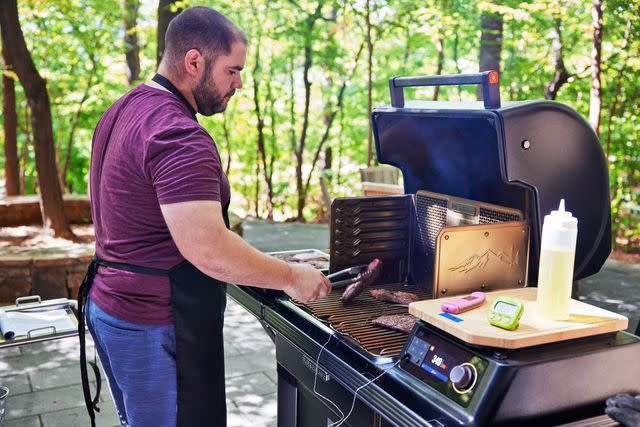
Food & Wine / Russell Kilgore
Best Value: Traeger Ironwood 885 WiFi Pellet Grill and Smoker
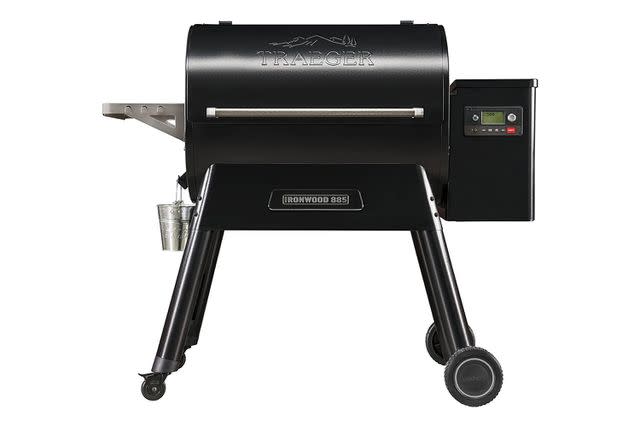
Pros: Many digital features and good heat retention work in this grill’s favor.
Cons: Despite the extra features, it didn’t generate a lot of smoke flavor, and the multi-grate design makes them difficult to scrape.
The Ironwood sits in the middle between the Pro 780 and the Timberline in terms of features, bringing more to the table than the 780 but not reaching the price point of the Timberline. So, in terms of features to dollars, it’s our pick for Best Value. The Ironwood includes a Downdraft Exhaust system, venting the older, cooled smoke from the bottom, and a Super Smoke mode, which purportedly delivers more smoke without increasing the cooking temperature.
Despite these features, the Ironwood didn’t provide as much smoke as expected in our baking and smoking tests. It showed, however, that it heats and recovers quickly, with reasonably good heat retention. It smoked and baked all of our test items well, but it stumbled on our steak-searing test, giving some faint grill marks and a very mild smoke flavor.
Price at time of publish: $1,500
Dimensions: 27 x 54 x 47 inches
Cooking Area: 885 square inches
Weight: 175 pounds
Max Temperature: 500 degrees Fahrenheit
Hopper Capacity: 20 pounds
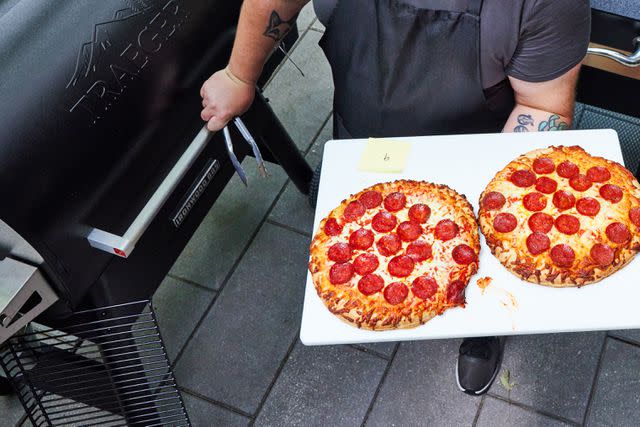
Food & Wine / Russell Kilgore
Best Portable: Traeger Tailgater 20 Pellet Grill

Pros: It’s an easily portable grill that heats quickly and performs as well as its Traeger peers.
Cons: It doesn’t produce as much smoke as we’d like, and a maximum temperature of 450 degrees Fahrenheit doesn't provide a good sear.
Despite a few size-related drawbacks, the Tailgater performed as well as, or better than, many of the larger models tested. It exceeded expectations in the smoking and searing tests. It struggled a bit on the baking part of the show, but that is primarily due to the pizza pushing the limits of the cooking area.
It heats and recovers quickly, retains that heat, and provides good smoke flavor in all aspects but one. The long-smoking test showed a lack of smoke flavor in the finished product, but it did yield an excellent bark on the pork butt. It’s a very good portable grill with the same control panel interface as larger models, but that portability means it lacks Wi-Fi connectivity. It leaks a bit of smoke and would sear better with a higher upper-temperature limit than 450 degrees Fahrenheit.
Price at time of publish: $530
Dimensions: 18 x 37 x 36 inches
Cooking Area: 300 square inches
Weight: 62 pounds
Max Temperature: 450 degrees Fahrenheit
Hopper Capacity: 8 pounds
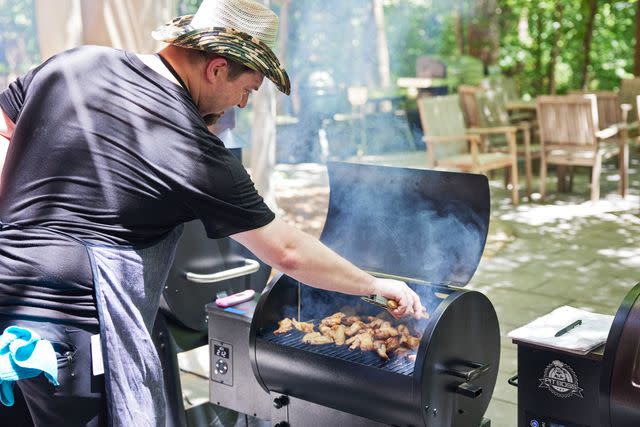
Food & Wine / Russell Kilgore
Our Favorite
When comparing the price to features, the Traeger Pro 780 provides value, consistency, and a wide range of added functionality that make it stand out from the competition.
The Tests
We tested all the grills through a series of tasks that any consumer would perform and rated them on a scale of 1 to 5, starting with setup. Traeger claims a temperature accuracy of +/- 15 degrees Fahrenheit in its controls, so the next step was to test that accuracy at the highest temperature. While at that temperature, our testers performed a searing test, judging visually how well the grill seared a steak. Working their way down the temperature scale, the subsequent tests evaluated how well the grills baked a frozen pizza at 425 degrees Fahrenheit and chicken wings at 225 degrees Fahrenheit, looking for consistency, grill marks, and smoke flavor.
For our top picks, our testers gauged how well the grills smoked a pork butt, judging the time to cook, any temperature fluctuations over the process, the bark development on the meat, and how much smoke flavor the meat retained. The final test, as any consumer would face, was the ease of cleanup. We then averaged the scores across each category and used that average to rate our top picks.

Food & Wine / Russell Kilgore
Factors to Consider
Size
When it comes to the size of a grill, the first factor to consider is how much outdoor space you have available to operate it safely. Next is the available cooking area of the grill. It’s a good idea to purchase a grill with a cooking space that’s a little larger than you’ll regularly need, just in case you want to cook something a bit bigger or for entertaining a larger group than normal.
Also consider the relative size of the hopper to the cooking area and the maximum temperature of the grill. If you like a hands-off approach to cooking, you’ll want to ensure that the hopper is large enough that you won’t have to refill it. Another consideration is how the hopper is accessed. If you must open the grill to refill the hopper, you’ll lose temperature, which could result in uneven cooking. So, you’ll want to ensure that the hopper is large enough to minimize that scenario.
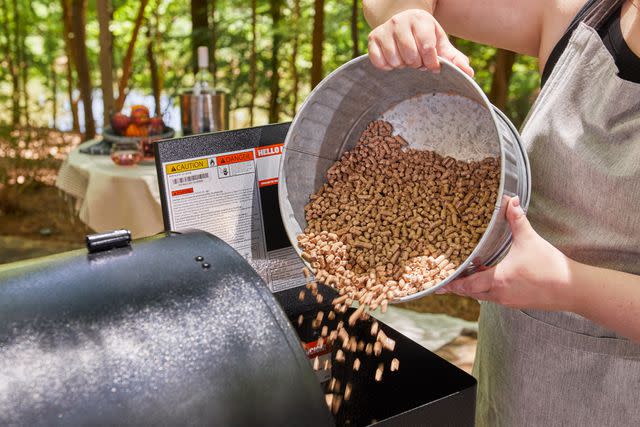
Food & Wine / Will Dickey
Features
The higher-end Traegers have fantastic features, but do you need them all? Wi-Fi or Bluetooth app connectivity make cooking a far less hands-on activity, but is that functionality something you’ll use regularly? If the answer is no, consider a model with similar size and heat capacities at a lower price point to attain the same goal. Also worth considering is the idea that more features mean more opportunities for a component to fail. While warranties are great, replacement parts aren’t instantaneously available, and the lack of a functioning feature could ruin your grilling plans.
Maximum Temperature and Heat Retention
There’s only a 500-degree difference in maximum temperatures between the newer, higher-end models and the older or portable models. If you want a good sear with your grill, you’ll want a model with a 500-degree upper limit, as 450 degrees Fahrenheit just isn’t hot enough to achieve a proper sear. While a high upper-end temperature is good, you’ll also want to consider how well the grill retains heat and how quickly it recovers temperature after opening it. Another worthwhile consideration is how quickly the grill attains the desired temperature. More prolonged heating and recovery times mean higher fuel consumption.

Food & Wine / Russell Kilgore
Frequently Asked Questions
Are Traeger grills worth it?
That answer lies in your expectations of the grill. After analyzing the test results, I think I’d use one for smoking, baking, or general grilling where a Maillard crust can build slowly. Traegers aren’t great for high-heat searing. However, the higher-end models' general hands-off capabilities and app connectivity appeal in many ways. They’re versatile – to a point – and make set-it-and-forget-it cooking extremely easy.
Where are Traeger grills made?
Traeger manufactured its grills in Oregon until 2010, when manufacturing moved to China to remain competitive in pricing.
How do you clean a Traeger grill?
The basic process is to spray the grates and the inside of the chimney with a mild degreaser or soap and let them soak while you clean the rest of the grill. Empty the grease tray and the hopper, remove any sawdust, and reassemble the parts. Then just wipe the grates, chimney, and exterior with a cloth or paper towel. A full description of the process can be found on Traeger’s website.
Other Traeger Grills We Tested
Traeger Ranger Portable Grill ($450 at Amazon)
Another in the portable class, at a slightly lower price point than the Tailgater 20, is the Ranger. While the Tailgater is a collapsible, mobile model, the Ranger is designed for tabletop use and has a slight advantage in the amount of space necessary to store and transport it. The Ranger is quick to heat, reaching maximum temperature more quickly than most of the other models tested here, and held temperature within five degrees of the setting on the control panel for most of the tests. It scored well on the short-smoke test, yielding nicely smoked chicken wings, and produced a moderate sear during our searing tests.
Because of the location of the drip pan, reflecting a large amount of heat to the grill, it did not fare well as a baking device. As one tester said, “the Ranger is a bang-for-your-buck kind of pellet grill,” but it faces some shortcomings. “For the size, the value is a five, but for the performance and functionality, it is a three,” he said.
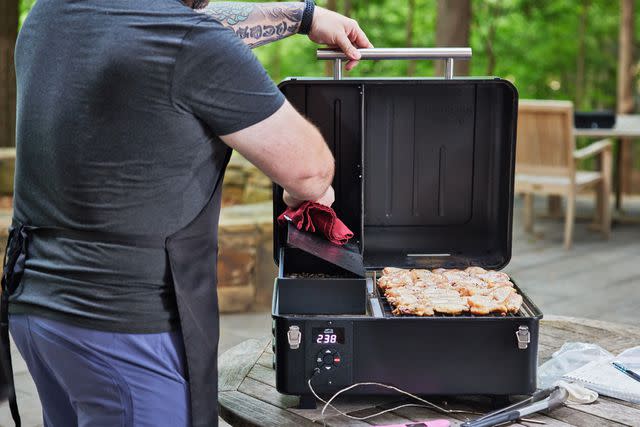
Food & Wine / Russell Kilgore
Traeger Pro Series 34 ($700 at Amazon)
Everything about the Series 34 is just OK. It's not excellent and certainly not terrible; it’s an average grill. It goes to work, pays the bills, has poker night once a week, has a beer in the backyard on weekends, and doesn’t make waves.
Part of the Gen 1 series, it lacks many of the features included in later models, like Wi-Fi or Bluetooth connectivity, and the control panel is not as detailed as its newer siblings. It performs well at lower temperatures but struggles to reach and maintain higher temps. In our short-smoke tests, it produced a large amount of smoke but yielded a moderate smoky flavor. The grill showed some cool spots at higher temperatures, especially near the door. If you’re a fan of big, smoky flavor, this may not be the grill for you. But if you’re looking for a safe, dependable, middle-of-the-road model, this grill will serve you well.
Our Expertise
Greg Baker is an award-winning chef, restaurateur, and food writer with four decades of experience in the food industry. His written work appears in Food & Wine, Food Republic, and other publications.
For more Food & Wine news, make sure to sign up for our newsletter!
Read the original article on Food & Wine.

